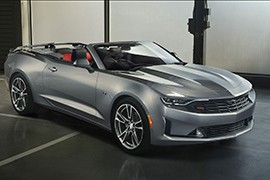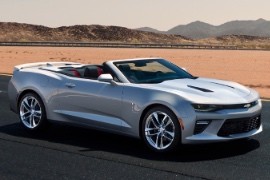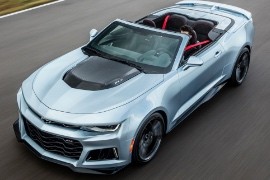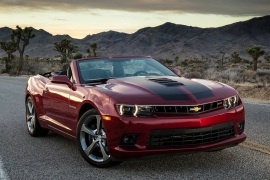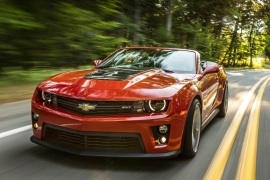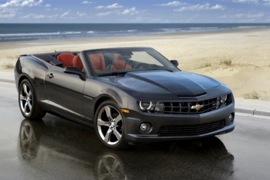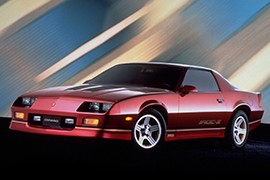CHEVROLET Camaro Convertible Models/Series Timeline, Specifications & Photos
First production year: 1984
Engines: Gasoline
Body style: Convertible (spider/spyder, cabrio/cabriolet, drop/open/soft top)
No doubt, the Camaro is an icon of the American automotive industry. Its name is connected to the pony-car wars and The Transformers franchise. But the need for a bigger market made GM to chop the Camaro roof of and make it a convertible. And, in 2019, this open-top went through a major facelift in order to be more appealing to the younger generation. That is why they gave it new LED-dual headlights and a reshaped hood.
Inside, there are enough features to stand-up to the new age of technology, with an infotainment unit that supports Apple CarPlay and Android Auto connectivity. And, due to its big wheelbase, it is a real four-seater, just with two doors.
The 2019 modifications brought the 10-speed automatic transmission with paddle shifters from the ZL1 version to the SS. Also, the 2.0-liter turbo engine was installed on a tailored chassis, derived from the V6 engine variants, which included a limited-slip differential and a six-speed manual transmission fitted as standard. The 275 hp and the 400 (295 lb-ft) of torque helped the convertible to move better in traffic, more fuel-efficient but still fast.
The 5.2 seconds needed for the 0 to 60 mph sprint (0-96 kph) place the convertible Camaro L1E in the hot hatch territory, but with rear-wheel-drive and a soft-top, which should make it better than a hot hatch.
Chevrolet introduced the sixth generation of the Camaro in 2015 as a 2016 model year, either as a coupe or a convertible, the latter being designed mostly for leisure cruises.
When Chevrolet followed the retro-design trend and introduced the fifth generation of the Camaro, it was a blast. It resembled the original 1967 version, and it rocked the pony-car scene threatening the Mustang. The sixth-generation continued the same design idea but with a meaner front fascia and a choice of three engines, including a turbocharged inline-four.
Its front fascia was slimmer, with a more angular, aggressive look. It seemed like the headlights were peeking through a narrow gap. On the bumper, Chevrolet installed a broad grille that cooled the radiator, and it was flanked by a pair of triangular air-inlets. The thicker A-pillars that supported the windshield were raked and short, while the back of the car was quite tall for the car's size. As an option, the carmaker offered a lip spoiler on top of the trunk.
Inside, the Camaro greeted its customers with bucket seats at the front with enough bolstering to help them stay in place during high-speed cornering. The bench in the back, on the other hand, offered limited legroom. Still, it was enough for two adults on short trips.
Under the hood, GM pulled some engines from its part bins and offered a choice of three powerplants ranging between 275 hp and 455 hp, the latter being a naturally aspirated V8.
The 2017 Camaro ZL1 Convertible was launched at the 2016 New York Auto Show. It was the performance version of the open-top Camaro.
The Camaro was offered in more bodywork versions over time, such as coupe, targa, or cabriolet. The Camaro started its career in the muscle-car era and it was one of the top performers of the era with its big engines under the hood. Unlike the Corvette, which was created as a sports car from the beginning, the Camaro was intended to be used more like a daily driver car.
The 2017 Camaro ZL1 Cabriolet featured a wider front side than its siblings. A wider body was needed to accommodate the wider, 285 tires on the front. Vertical LED running lights were incorporated in the outer air-intakes on the bumper. The big, front grille was black with a mesh-pattern. The hood was different than other Camaro convertible, to leave some room for the bigger engine. In the rear, a trunk-spoiler was installed more for image than for usage and it was a carry-over from the rest of the convertible range.
Inside, the bucket-seats were fitted as standard, and a pair of Recaro sport-bucket seats were offered as an option. The rear bench was profiled for two seats. With the roof down, a lid was on top of the retracted soft top. The suede and other expensive materials were on the dashboard, seats, and door panels.
Under the hood, there was an LT4 engine that could have been mated to a 6-speed manual or a 10-speed automatic transmission.
Chevrolet refreshed the fifth generation of the Camaro in both shapes, coupe and convertible, unveiling it on the European continent at the 2013 Frankfurt International Motorshow.
The American automaker introduced the fifth generation of the Camaro in 2009 for the 2010 model year, re-igniting the customers’ passion for pony and muscle cars. The new model came at the right time when the world started to recover from the financial crisis. As a result, the Camaro, in its shapes as convertible and coupe, got good results. Unfortunately, it couldn’t pass the 100,000 units mark/year. Still, with constant deliveries of over 80,000 units yearly, it stayed in people’s hearts and minds. In the U.S., the bow-tie brand had already introduced several updates between 2010 and 2013, but now it was time for a big refresh. Strangely, though, the car manufacturer chose Europe to show it, even though the model was more attractive to American buyers.
Even if it didn’t show its age, the Camaro needed some tweaks and upgrades both on the exterior, interior, and engine. From the outside, the facelifted model featured a broader front fascia with recessed, round headlights that flanked the broad black grille, which was also narrower than before. In addition, the automaker added a functional vent on the hood that helped cool the engine and reduced aerodynamic lift. From its profile, the low-slung shape of the vehicle remained similar to its non-facelifted version, with a three-slat fake vent in front of the rear wheel arches on the quarter panel. Customers could cover and uncover the cabin by manually unlatching the rag-top and then pushing a button to retract it behind the rear seats. As a result, when the top was down, apart from the A-pillars, there was nothing to interrupt the car’s line above the waistline. Finally, at the back, the car featured wide horizontal taillights and a lip spoiler on the trunk’s lid. The spoiler also concealed the antenna for the infotainment unit.
Inside, the automaker’s design team worked hard and reshaped the cabin. It installed a new, seven-inch touchscreen on the center stack for the infotainment system. The bolstered front seats were available with man-made leather upholstery. They were separated by a tall center console that housed an armrest with cubby storage underneath, the gear stick, and the manual hand brake. Fronting the driver was the instrument cluster with two large dials for the speedometer and tachometer that flanked a TFT display. In the rear, the Camaro had enough room for two passengers on the bench seat, although legroom was not as good as in the coupe version.
Under the hood, Chevrolet installed a range of gasoline engines with six or eight cylinders paired with either a six-speed manual or a six-speed automatic. Versions fitted with automatic transmissions featured active fuel management and cam phasing to increase fuel efficiency.
At the 2011 Los Angeles Auto Show, Chevrolet introduced its most powerful convertible until then: the Camaro ZL1 Convertible. It features the same ZL1 engine with 588 hp and 754 Nm (556 lb-ft) of torque as the ZL1 Coupe. The hardest part of Chevrolet's engineers' team was to stiffen the vehicle and made it performs more like a coupe than a convertible.
The designer's team was also challenged to make the vehicle look great whether the fabric top was up or down. In the end, the result is a big 4.8 meters (15.9 ft) long car with a 2.9 meter (9.3 ft) wheelbase, able to accommodate four passengers without compromise on the rear seat legroom.
Under the hood is the famous 6.2-liter V8 supercharged engine mated to a standard 6-speed manual or an optional 6-speed automatic. This setup is good enough to propel the car from standing still to 100 kph (62 mph) in under 5 seconds and take it to a top speed of 250 kph (149 mph).
To reinforce the bodywork, Chevrolet installed a new brace under the hood, a reinforcement brace for the transmission, another underbody tunnel brace and a stiffer cradle plus an X brace under the engine compartment. This way, even if the car is heavier than the coupe, at least it won't have a torsion feel when fast cornering.
After some delays due to the global economic crisis, Chevrolet finally decided to launch the Camaro Convertible in January 2011. It was winter, but the orders quickly pushed the delivery time to spring.
The Camaro Convertible concept was shown as a concept-car in 2007, but by the time the project was finished, the financial crash hit hard the automotive industry and GM barely escaped from bankruptcy. It suffered, but remained standing up. In 2010, the Camaro Convertible project was brought back to light. Final touches and calculations were made and the assembly line was ready to start production. A small pre-series was made in December 2010.
It is hard to make a convertible to look better than the coupe version. Somehow, the GM designers succeed it and made it happened. While the front side and the beltline remained the same with those found on the coupe version, the fixed roof was replaced by a canvas top. It was completely retractable behind the rear seats, under a cover. The side rear windows were smaller, but they were retractable. The absence of a B-pillar was a good visual improvement.
Inside, there was a 2+2 configuration, and there was enough legroom for the rear passengers. The rest of the car interior and features were similar to the coupe version, including the front bucket-seats.
The Camaro Convertible was available in the LT and SS trims. The base model for the coupe version, the LS with the V6 was not available.
Chevrolet introduced the third generation of the Camaro in late 1981 for the 1982 model year, and three years later, it unveiled one of the most desirable versions for it: the IROC-Z.
The American automaker sponsored the International Race Of Champions and reserved the rights to put the IROC name on a special version of the Camaro. But it was more than just some stripes and a nicer set of wheels for this F-Body sports car. It became the “Baby Vette” that managed to lower the zero-to-sixty run in under seven seconds for its family. And the 1985 model year was just the beginning, and it started as an option package for the Z28 Camaro.
Chevrolet bragged about sponsoring the IROC with this version and let everyone know when it placed IROC-Z decals on the doors. Underneath them, an elegant stripe marked the limit between the bodywork panels and the side sills that improved the ground effect. To differentiate the car even more from its mundane siblings, GM added a set of five-spoke alloy wheels with a unique design for this top-spec version.
Inside, the bolstered front seats with integrated headrests provided some side support for their occupants during high-speed cornering. In addition, two more people could sit in the rear, on the bench, albeit not very comfortably. Finally, the center stack hosted the audio system that featured an auto-reverse tape player, which was a special thing in those times.
Under the hood, the 1985 IROC-Z featured an iron block, 5.0-liter V8 paired with either a five-speed manual or a four-speed automatic. Later on, the IROC-Z received an improved 5.7-liter unit.
CHEVROLET Camaro IROC-Z28 5.0L V8 4AT RWD (155 HP)
CHEVROLET Camaro IROC-Z28 5.0L V8 4AT RWD (170 HP)
CHEVROLET Camaro IROC-Z28 5.0L V8 4AT RWD (215 HP)
CHEVROLET Camaro IROC-Z28 5.0L V8 4AT RWD (230 HP)
CHEVROLET Camaro IROC-Z28 5.0L V8 5MT RWD (155 HP)
CHEVROLET Camaro IROC-Z28 5.0L V8 5MT RWD (170 HP)
CHEVROLET Camaro IROC-Z28 5.0L V8 5MT RWD (190 HP)
